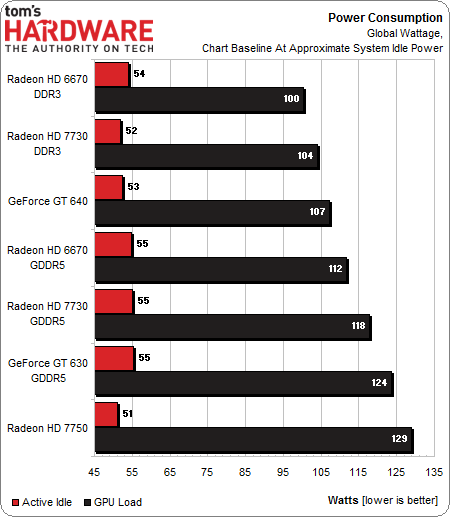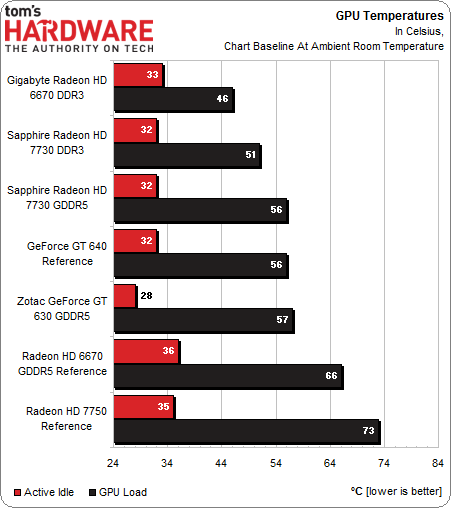AMD Radeon HD 7730 Review: A Harbinger Of The Kaveri APU?
We got our hands on two Radeon HD 7730 cards from Sapphire: one with 2 GB of DDR3 and the other sporting 1 GB of GDDR5. How do they compare to AMD's Radeon HD 6670s, and what might we glean from these boards about the upcoming Kaveri-based APUs?
Power And Temperature
Power consumption is measured at the system level, and we're using Metro: Last Light as our workload to gauge peak draw.
I zeroed this chart out at 45 W, which is roughly where the system idles when we don't have a graphics card installed. This gives us a more visual representation of each card's power consumption relative to the rest of the field.
There's a 29 W difference between the top and bottom boards under load. As we expected, the Radeon HD 7750 is the most power-hungry entry. We're also a little surprised to see the GeForce GT 630 GDDR5 following just 5 W behind. The DDR3-equipped Radeons use the least amount of power, and the new 7730s pull more from the wall than their predecessors, despite a lower TDP specification.
When it comes to thermal performance, cooling solutions have a big impact. So, I've included manufacturer names in the above chart to indicate cards with non-reference heat sinks and fans.
I zeroed out the chart at our lab's ambient temperature of 24 degrees Celsius. Although Gigabyte's Radeon HD 6670 with DDR3 posts the lowest GPU temperature under load, Sapphire's Radeon HD 7730 cards perform well in this comparison, too.
Get Tom's Hardware's best news and in-depth reviews, straight to your inbox.
Current page: Power And Temperature
Prev Page Results: Company Of Heroes 2 Next Page Radeon HD 7730 Is Good, If The Price Is RightDon Woligroski was a former senior hardware editor for Tom's Hardware. He has covered a wide range of PC hardware topics, including CPUs, GPUs, system building, and emerging technologies.
-
rmpumper Just look at that performance difference between DDR3 and GDDR5. AMD sure needs to implement GDDR5 in Kaveri in order not to waist all that GPU potential.Reply -
designasaurus Reply11292234 said:Just look at that performance difference between DDR3 and GDDR5. AMD sure needs to implement GDDR5 in Kaveri in order not to waist all that GPU potential.
Your comment, while being perfectly accurate, actually made me notice something interesting. Take a look at the charts, and you'll see that the GCN 7730s are less affected by the switch from DDR3 to GDDR5 than the VLIW 6670s! That means GCN is leaving less performance on the table if it's paired with slower memory, which is ideal for the situation an APU is usually in (PS4 aside). -
Onus At the right price, this looks like a real winner, especially the GDDR5 version. If a $90 HD7750 is too rich, an HD7730 for $65 looks like it is still capable of playing most games, especially at 720p resolutions where a lot of HTPC cards operate.Reply
The "secret sauce" that could really catapult this one would be if some of its disabled pieces might be able to be switched on.
-
ET3D Regarding Kaveri, it looks from this that CGN means better performance with DDR3, but also higher power consumption. If AMD wants to keep to the same power envelope it might have to reduce GPU clock speeds, which will eat into the performance advantage. In the end, it feels from this that Kaveri will offer only a minor performance boost.Reply
Hopefully AMD has done more power optimisations and that won't be the case. -
shikamaru31789 I'm a little dissapointed if this is what we can expect from Kaveri. I was hoping for something that would come closer to matching the APU in the Xbox One. I want to build a small HTPC for gaming in my living room, and an APU would have been ideal for that since the smaller HTPC cases don't have room for large discrete graphics cards. I don't know, maybe Kaveri could still be useful if they actually get Hybrid Crossfire working properly, a Kaveri APU paired with a discrete 7730 and DDR3 2133 might just work out for my purposes.Reply -
slomo4sho I don't see why manufacturers continue to utilize this ram in newer products... Just get rid of DDR3 already...Reply
Also, how is this Cape Verde GPU a "Harbinger Of The Kaveri APU"? It is a trimmed down 7750 and since a 7750 can provide no real insight into the performance of upcoming Kaveri APUs then how does this entry level card provide any better insight? -
army_ant7 On page 10, does the reference HD 7750 really have a load temp of 97C?Reply
(73C + 24C ambient = 93C)
Anyway, the GDDR5 HD 7750 looks like a viable game-enabler for PC gamers on a budget. Also, it's a nice refresh for that price point's options. I do hope it sells for around $60 or less. :-D -
sarinaide Reply11292661 said:I'm a little dissapointed if this is what we can expect from Kaveri. I was hoping for something that would come closer to matching the APU in the Xbox One. I want to build a small HTPC for gaming in my living room, and an APU would have been ideal for that since the smaller HTPC cases don't have room for large discrete graphics cards. I don't know, maybe Kaveri could still be useful if they actually get Hybrid Crossfire working properly, a Kaveri APU paired with a discrete 7730 and DDR3 2133 might just work out for my purposes.
I have found a Trinity based APU more than enough for a HTPC. I would not have banked on Kaveri matching the XB1 and PS4's custom build silicon as in the name the APU designed for MS and Sony was of custom design and the hardware was always going to scale beyond that for desktop parts. If you offered me HD7730-7750 performance on a Kaveri I would be very pleased with that. What hasn't been brought to light is that the Spectre IGPU on Kaveri features around 512 Stream Processors and increased ROP's and compute units so it may very well be a potent iGPU.
Dual Graphics has improved with Catalyst 13.8 to the point it is now playable, if a Richland can DG with the HD7730's that would be tremendous fo gaming under $200 for chip and card.

